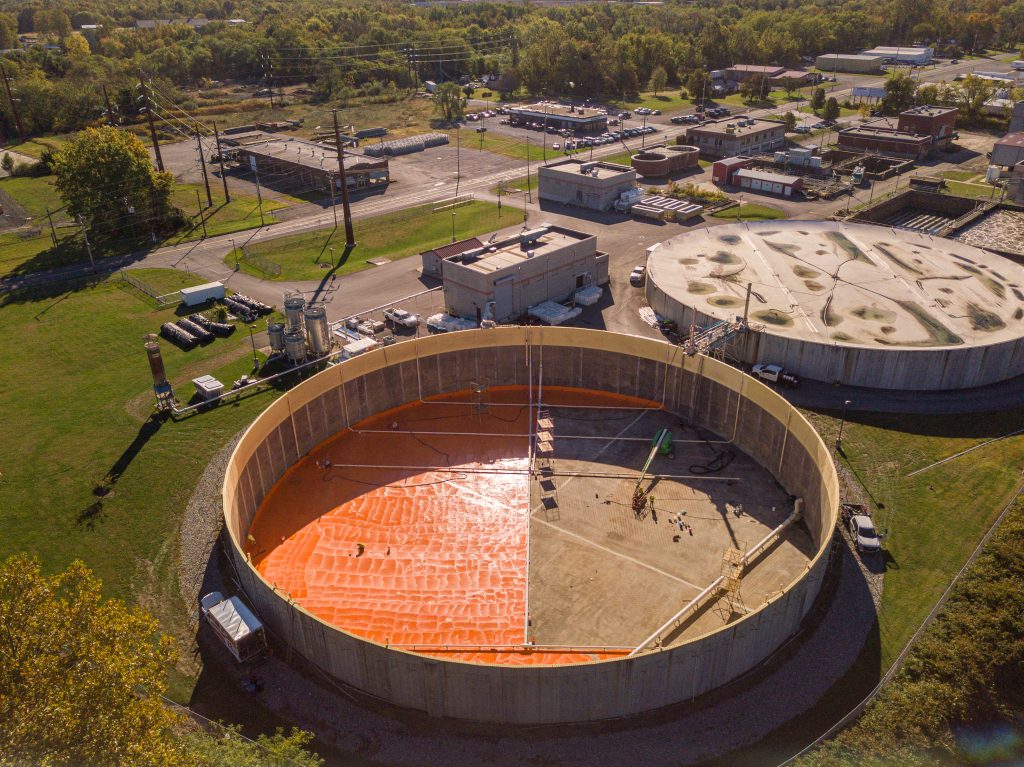At the Milton Regional Sewer Authority (MRSA) in Pennsylvania, wastewater treatment is about managing flow and about generating power. Every day, the facility processes roughly one million gallons of wastewater from a major food manufacturer, using an enormous 7.5-million-gallon anaerobic reactor tank to treat the waste and produce methane gas for electricity.

“The tank’s been in service since about 2013,” Genie Bausinger, Executive Director of MRSA said. “In the early 2020s we found some deterioration near the top where our gas is stored and realized we had an issue we needed to address due to the corrosive nature of the gas that we generate.”
To ensure long-term reliability and prevent further damage, MRSA turned to Advanced Rehabilitation Technology (ART), an OBIC-certified installer, to fully restore the tank’s interior.
How do You Drain a 7.5-Million-Gallon Tank?
Before ART could begin any surface preparation, MRSA had to take on the difficult task of draining the 7.5-million-gallon anaerobic reactor tank, a process that required patience, planning, and collaboration.
“It doesn’t have drains,” Genie Bausinger, Executive Director of MRSA said. “It’s 34 feet deep and 207 feet in diameter, so it was a slow process to drain.”
Her team first used pumps to remove roughly a foot and a half of water from the tank. “The rest of it we used a trash pump, and then we got to a point where that pump couldn’t pull anymore,” she said. “We enlisted a local contractor with a hydrovac excavation truck to remove the remaining solids and wastewater. That process took about a year and a half all in. We learned a lot through it, so when we do the second one, it should go faster.”
Taking on the Biggest Tank Yet: The Milton Challenge
Once the tank was drained, the team discovered that the damage ran deeper than expected. “It wasn’t just the gas,” she said. “We found abrasion going on in the floor, and the polyurea product will not only protect from abrasion but also from H₂S corrosion.”

Hydrogen sulfide, common in anaerobic environments, is one of the most destructive forces acting on concrete. Combined with the tank’s constant exposure to moisture and pressure, it posed a serious risk to longevity.
MRSA had explored several solutions over five years before selecting OBIC’s proven Armor Multi-Layer System, a combination of OBIC 1306 closed-cell foam sandwiched between two layers of OBIC 1000 polyurea that would be installed by our experienced crew members.
For Rusty Hesselschwardt, Business Development Manager at ART, success started long before the first spray. “My wheels get to turning on prep,” Hesselschwardt said. “Prep is key to everything you do, and it’s the first thing I always look at. If you can get it prepped, we can get it sprayed.”

That preparation included hydroblasting, cleaning, drying, and setting up equipment for optimal workflow. Given the size of the structure and a tight deadline, ART mobilized three trucks and a crew of six to eight to keep the job on schedule.
“They wanted it done by the first of November,” he noted. “So from the very start I knew I needed three trucks here and the right number of guys on the jobsite.”
Weather quickly became one of the biggest hurdles. “An open-top tank in November gets very interesting,” Hesselschwardt said. “Rain shut us down for a couple days and was the main concern. The rental company also backed us up a week when equipment was delayed. But we adapted and kept everyone communicating, and that’s what keeps a job like this on track.”
Lessons from the Field
Even with decades of industry experience, Hesselschwardt says every project provides new takeaways. “Don’t be afraid to spend on rental,” he advises. “This tank’s different with so much piping in the bottom, but with the boom lift and scaffolds, have more than you think you’re going to need. The more setup you do, the better off you’ll be. Being prepared and getting opinions from your team saves a lot of hassle.”
The team’s planning paid off. ART completed the install in under a month, even with weather delays. “The ART team was great and communicative,” Bausinger said. “It was coated in under a month, so we’re very happy with that.”
Why OBIC Polyurea was the Perfect Solution
The tank’s immense concrete structure was another factor in product selection. “It’s a big concrete tank, so it’s a living, breathing entity,” Hesselschwardt explained. “When it freezes and thaws, it moves. You see a lot of epoxies get microfractures. Our 400% elongation polyurea moves and breathes with the concrete, so it’s not going to crack.”
OBIC’s multi-layer system filled existing cracks and voids, creating a flexible yet durable barrier against corrosion and abrasion. “Multi-layer is the answer to everything,” He said. “We filled the seams and cracks with foam, and it’ll extend the life by 50 years or more.”
“We’re not afraid to stand behind the work we do,” Hesselschwardt said. “I’m proud of the guys. It’s awesome.”
For MRSA, the restored tank represents more than an infrastructure upgrade. It ensures continued renewable-energy generation and wastewater processing for years to come.
With each successful restoration, ART continues to raise the standard for infrastructure rehabilitation. Whether you’re protecting a digester, clarifier, or equalization tank, our certified specialists deliver precision craftsmanship backed by industry-leading products built to perform.
ART is an OBIC-certified installer and can offer high-quality, long-lasting solutions for a wide range of applications. For more information about how we can help your wastewater treatment plant, call 419-636-2684.



